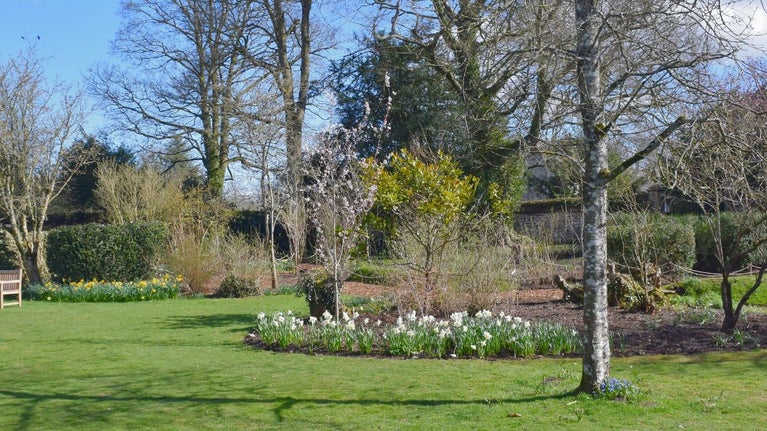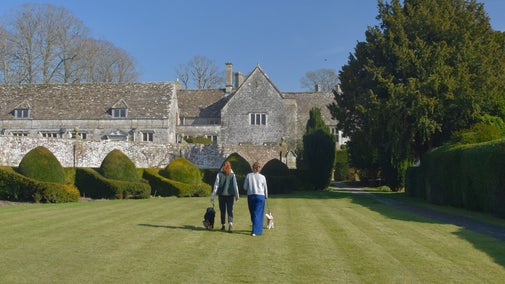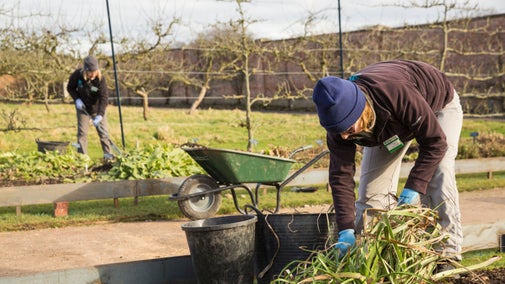
Discover more at Avebury
Find out when Avebury is open, how to get here, the things to see and do and more.

The garden at Avebury Manor is arranged as a series of 'rooms', each with a different name and individual character. Take your time to explore and discover or simply take a seat and enjoy the sights and scents around you.
Mature trees, decorative topiary, clipped hedges, shrubs and climbers are enhanced by ornamental herbaceous borders, seasonal displays, colourful beds and a wildflowers meadow.
The garden is completely accessible by wheelchair or mobility scooter. There is also a map available from the Great Barn or the Monk’s Garden that shows which garden entrances have access without steps.
If you are looking to relax, the Church Garden is sheltered from the wind and provides a great place for picnics, reading and relaxation.
The Orchard in Avebury Manor Garden is also registered as a Silent Space. Here we would encourage you to switch off, take a few minutes and listen to nature.
The Kitchen Garden includes a wide range of organically grown produce and cut flowers, all of which are regularly harvested and displayed for visitors to see and take home in exchange for a donation.
The gardening team are working to increase and extend the availability of produce, and this will change according to the time of year.
Any contributions left in the donation box are welcome and will be used to look after the garden.
The Monk's Garden includes a wide variety of herbaceous perennials and annuals, including vegetables to enhance the potager style planted earlier this year.
Horticulturally the Monk's Garden presents the greatest challenge to the gardening team because it has a challenging micro-climate.
Our aim is to improve this important space in terms of its resilience to weather extremes.
There are two key aspects to the Church Garden. One is the stunning flowering display in the hot border which includes plants such as Clematis ‘Ernest Markham’, Helenium ‘Moreheim beauty’, Achellia ‘Terracotta’ and Campsis radicans.
The second is a reminder to those who visit Avebury that the Church Garden is the perfect place to rest and reflect, and for children to play (with garden games available in good weather).

We've faced the challenge of the lattice shaped topiary being stricken by box blight and its selected replacement (Lonicera nitida - shrubby honeysuckle) succumbing to extremes of temperature over the last year.
However, we are pleased to announce that work has begun to replace the topiary with yew (Taxus baccata), arguably one of the most resilient and reliable evergreen plants growing in the UK.
Restoration of the Lavender Walk in the East Garden is also underway, with a new variety planted which will be more resilient to changes in climate.
The old lavender has been removed, with late winter bulbs (snowdrops and winter iris) added to the beds.
In addition to the new lavender, we will plant a great number of snowdrops and winter iris bulbs. The snowdrops will be Galanthus nivalis and the Winter Iris will be Iris reticulata.
The South Lawn was the original entrance way to the manor and was previously partly a cherry orchard.
If you walk to the back of the garden, you’ll find a poignant reminder of earlier lives with the gravestones of pets long gone. Although some are hard to read, others are inscribed with ‘Herbie my faithful friend’ and ‘Adorable Daisy’.
A new sensory woodland walk is now open at the southern end of the South Lawn, with a series of island beds linked by a meandering, natural path.
New trees and shrubs have been planted that were not previously grown, along with new herbaceous planting. More plants are being gradually introduced providing a much-increased range of plants designed to broaden seasonal interest and provide added structure, colour, and scent.
This part of the garden has arguably the loudest and most varied birdsong and new views of Avebury Manor can now be seen and enjoyed for the first time in over a century.

On a stroll down the Lion Walk you’ll see colourful herbaceous borders, with floral highlights including achillea, echinops and phlox.
Grass paths are cut through longer areas of grass in the Orchard to encourage wildflowers and attract beneficial wildlife.
Seasonal plants include wild thyme, dropwort, corn marigolds, field daisies, lady's-bedstraw and cornflowers.
The highlight of the East Garden is the wonderful lavender walk which leads to the front door of the manor, flanked on either side by formal lawns.
Explore the furthest corner of the garden to find a double row of 58 clipped yew columns.
This has its name because of the curved brick wall which acts as a backdrop to climbers and provides additional warmth for herbs growing along its base.
In front of this, a yew hedge replicates the shape and is the perfect foil for an extensive pastel-hued herbaceous planting divided up by clipped yew and lonicera.

In recent years, one of the overriding challenges at Avebury Manor Garden is to find solutions for the climatic extremes which have been recorded here and obviously affect everybody.
Some of these are as follows:
We’ve migrated towards a completely organic horticultural practice, which we are already seeing benefit the wildlife and pollinating activity in the gardens.
We have deliberately allowed the height of the lawns to increase enough to allow clover to flower and attract bees, hoverflies, and other pollinators. Although, as part of the management of the lawns, we also ensure that they are well maintained.
A significant preoccupation of the gardening team is to ensure that our garden compost is returned to the soil as an invaluable mulch to conserve moisture and sustain good soil health.
As well as being home to hedgehogs, the garden is a haven for a huge variety of wonderful creatures, including grass snakes, great crested newts, stoats, numerous species of butterfly, ladybirds, dragonflies, mayflies, bees and other beneficial insects.
Among the more common garden birds, others such as goldfinches, woodpeckers, red kites, buzzards, owls, house martins, swifts and tree creepers visit or live in the garden.
Take a seat on one of the benches and see what you can spot.

Find out when Avebury is open, how to get here, the things to see and do and more.
Visiting Avebury and the surrounding landscape is a unique experience. The area contains multiple Neolithic and Bronze Age features including the largest stone circle in the world which you can enter and explore.

Discover artefacts from archaeological excavations in the museum. Step inside the large threshing barn and see the 16th-century dovecote near the wildlife pond.

The Circles Café serves lunches, cakes, snacks and drinks. Visit the National Trust shop for sustainable products and gifts, or browse Cobblestones second-hand bookshop.

Avebury is a two pawprint rated place. With miles of space to explore, dogs love walks at Avebury. Find out where they can go and where to find water bowls and treats.

From 18th-century water gardens and Arts and Crafts landscapes to intimate woodland gardens, there are so many places to discover.

Discover our gardeners’ top tips so you can make the most of your garden, plot or window box.
